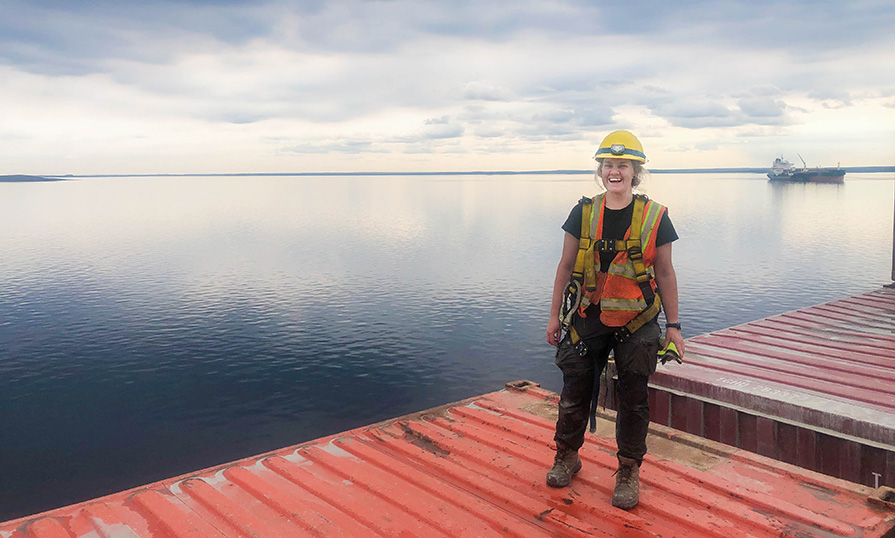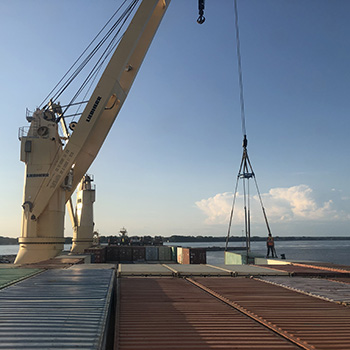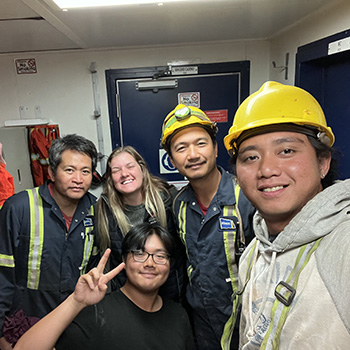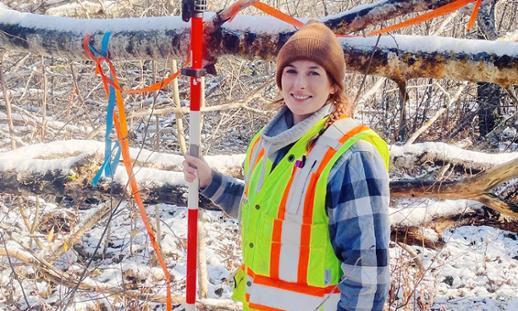A day in the life: Olivia Ferguson

Get to know Olivia, a Marine Navigation Technology student
Name: Olivia Ferguson
Program: Marine Navigation Technology
NSCC Campus: Strait Area
Class of: 2023
What brought you to NSCC and this program?
Though I didn’t know it at the time, my love for the ocean began when I moved to Nova Scotia at the age of nine. I was enrolled in the local junior sailing program and spent the majority of my summer months on the water. Due to my eagerness for adventure, I later found myself spontaneously sailing and travelling around the world in search of any and every sailing opportunity I could get my hands on. I’ve since sailed in Canada, the United States, UK, Europe, Australia, and the Arctic! I’ve sailed on charter boats, sailing yachts, fishing vessels, tall ships, and now commercial vessels. After several years I came to the realization that if I wanted to move up the ranks, I needed to acquire some sort of certification. At this point being on the water was more than a hobby and I knew I was interested in perusing marine navigation as a career. I struggled to find a clear path to reach my goals. My mother (bless her soul for patiently supporting me as I vanished off the grid time and time again while sailing the high seas) came across this program online and pointed it out to me, that’s when I promptly enrolled.
What has been your most memorable NSCC moment so far?
My favourite memory of NSCC has not been the program itself but rather the people I have forged connections with along the way. My life up until September of 2020, the first day of school, was utterly nomadic. Renting a place and settling in for the three years ahead ultimately led me to buying a small sailing dinghy, I suppose one could say I was missing my life on the water. One windy, fall afternoon my classmate Ryan and I decided to take my boat Prelude out for a spin. As white caps crested every wave, we made our way back and forth across the strait several times. On our last lap before calling it a day, the sails caught a strong gust of wind, so blusterous we turtled the boat! That gust rendered Ryan and I floating in the water hanging on to the side of my upside-down boat. Ryan held the bow of the ship into the wind, and I crawled on top of the hull and began to turn it right side up. We were successful and I crawled back in, but Ryan was not so fortunate.
As Ryan clung to the side of the boat, the wind had pushed us concerningly close to the wharf and I knew we needed to be making our way out of there. I tried my darndest to drag him back in the boat but to no avail. That’s when Ryan looked at me with a very solemn look on his face and asked if I could go on without him.
What he would I be capable of sailing the boat back to land as he clung to the side, but I thought he was asking if I would leave him floating in the strait and take the boat back in by myself. Determined to leave no man behind, I thought to myself “Not a chance!” By some burst of adrenaline, Ryan got back in the boat, and we made our way back to land, knowing with certainty that was enough sailing for one day. We get into laughing fits over that story to this day and had I not enrolled at NSCC I would have never met Ryan and this whole escape would never have happened.
What do you love most about your program?
First and foremost, my classmates. We’ve developed what I believe to be lifelong connections as the marine industry, though spanning the globe, is indeed still small. We’ve grown into a family.
I also thoroughly enjoy the summer placements where we get to work hands-on expanding our knowledge at sea.
What do you plan to do when you graduate?
Like any valuable goal, achieving my aspirations will take time. I plan to finish my 365 days of sea time and then complete the Transport Canada examination to become a Watch Keeping Mate. From there I would like to become certified to navigate in polar waters and perhaps one day become an Ice Pilot. My wildest dream would be to move to New Zealand and work as a navigator onboard a circumnavigating racing yacht.
What advice would you give to a friend considering NSCC / your program?
I reiterate this frequently but the words I like to live by and the one piece of advice I would give to anyone considering this career is, “If your dreams don’t scare you, they aren’t big enough.”
A day in the life
Morning
06:45 - My alarm rings at quarter to seven and I enjoy basking in my bunk for a few extra minutes. Weary eyed, I get up and prepare for the day just like everyone else. The best advantage of working at sea is that there is no commute to work!
07:15 - I make my way to the mess (dining room) and make a cup of coffee before getting my breakfast. I usually eat oatmeal or eggs and bacon accompanied by a few pieces of fruit.
07:45 - Everyone meets on the Main Deck to get dressed and ready for the day ahead. We dress for the weather, apply bug spray, (because the mosquitoes in Baker Lake are more than plenty) and put on our personal protective equipment such as a hard hat, fall arrest harness, gloves, high visibility vest and safety glasses.

07:55 - Just before 8 am we convene in the Officer’s Office to hold a Toolbox Talk. What is a Toolbox Talk you may be asking yourself? It’s an important safety meeting that we hold with all crew members, each morning, before starting work. It gives us a chance to talk about the job at hand. We are assigned work partners and jobs that need to get done that day, then we think out loud, clarify, ask questions, and talk about the inherent safety risks and how to mitigate them.
08:00 - Our vessel is too large to sail the entirety of the Thelon River and often northern ports tend not to be as infrastructurally developed as their southern counterparts. As a result we must meet a barge to unload our cargo, using our ships cranes. The barge usually arrives around 8 am which is where, under the guidance of our Chief Mate, we catch the mooring lines and tie the barge up to our ship. When we do this our ship is already at anchor, therefore the barge and the tugboat that brought it to us can just sit alongside the hip of our vessel for the day while we work.
08:30 - We split into our teams of two or three and go to the location we have been assigned at the morning meeting. Depending on where we are at in our loading/discharging operations, we will either be working down in the cargo hold or on top of the hatch cover moving containers and machinery to the barge.
09:00 - We also need to send a few of our crew over on the barge to be on the receiving end of the cargo operations. Because every piece of cargo needs to be manually rigged for lifting via the crane, we need teams both on the barge and on the ship.
10:00 - The type of cargo dictates our lifting arrangements for getting it off the ship. On this trip we have primarily containers; to move them we use four metal container hands that twist and lock into place that are then attached to Kevlar slings that lead up to the crane hook. On average it takes a few minutes to move each container. This trip we had 500 containers onboard.

11:00 - It is essential that we are looking out for ourselves and each other. When working heavy lifts and general cargo it is crucial to remain vigilant throughout the entire operation. This means looking out for trip and fall hazards, pinch points, and standing well clear of the moving cargo. We are a team, and we care about each other, we ask for help if we need it and remember that no cargo is more valuable than your life.
Afternoon
12:00 - At noon we are all starving from climbing up and down ladders all morning and doing the labor-intensive cargo work. We bring the personnel back from the barge and all head inside for a quick bite to eat. A big lunch is important as it gives us energy to keep us going throughout the day.
12:45 - We get dressed to work again and head back out to our positions on deck.
13:00 - Once we finish unloading all the cargo from on top of the hatch covers, we move down into the holds to start unloading. To access the holds with our cranes we must first move the hatch covers. They are hydraulically operated by the Chief Mate and a team of deck personnel who ensure the hatch is free to roll with no obstructions.
14:00 - We may also need to move the tween decks periodically during the cargo operations. A tween deck is essentially an “in-between deck” which divides the hold into an upper and lower section, longitudinally. The tween deck is broken into six panels which are easily picked up by the crane and stacked out of the way to allow access into the lower part of the hold.
15:00 - If we are carrying general cargo such as pick-up trucks, heavy duty machinery or steel pipes we must first unlash it. This individually packaged cargo must be well secured for transit using rachet straps or steel lashing chains. When it is time to lift this cargo, a team heads down to free the cargo and prepare it for lifting.
16:00 - My favourite part of the job is working general cargo as it requires unique lifting arrangements to attach it to the crane and bring it over to the barge. We may have to use large chains, wires and hooks, mesh or Kevlar slings on spreader beams. We must always lift heavy general cargo with extreme caution.
Evening
17:00 - We head inside for dinner. And to no big surprise, we are usually starving by this time.

17:45 - If we still have more space to load cargo on the barge, we will head back out on deck after dinner for a few hours to keep unloading from the ship. We will also always take “retro” or empty containers that need to be returned to Quebec. Towards the end of our cargo operations, we will load the empty containers from the barge then into the holds and on top of the hatch covers to maximize our efficiency in cargo transport.
19:00 - On this vessel we are usually finished for the day around 7pm. At this point the barge is fully loaded with our cargo that must be taken up the river to Baker Lake. Our ship will coordinate the departure time with the barge team, and we will standby on deck letting go the lines of the barge so they may depart.
19:30 - We spend the last half-hour or so tidying up the decks to keep it neat, free of hazards and ready for the next day.
20:00 - We’re finished for the day, so we head inside to shower and relax. Sometimes the crew will get together to play instruments or watch a movie in the lounge.
22:00 - By this time I am completely exhausted, so I lay in my bunk and promptly fall asleep. It’s important to rest as much as possible as this type of work requires high precision and focus to stay safe. When I wake up, I’ll get ready to do it all over again until the cargo operations are finished and we are sailing south once more.
Related Stories
 A day in the life: Gabriel Bajao
A day in the life: Gabriel Bajao
Follow along with Gabe, a Business - Tourism student at NSCC as he goes on a fam tour with his class to Nova Scotia's South Shore.
 A day in the life: Kailey Graves
A day in the life: Kailey Graves
Get an inside look into a day in the life of Kailey – a geomatics engineering technology student and mom of two in the Annapolis Valley.

